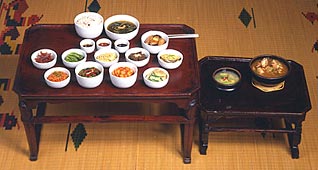Table settings and manners in Korea
The prominent feature of a Korean table setting is that all dishes are served at the same time.
Traditionally, the number of side dishes varied from 3 for the lower classes to 12 for royal families. Table arrangements can vary depending on whether a noodle dish or meat is served. Formal rules have developed for table setting, demonstrating the attention people pay to food and dining. Compared to neighboring China and Japan, a spoon is used more often in Korea, especially when soups are served.
The Ban-sang setting is mainly composed of a rice bowl along with side dishes for daily food table settings. Ban-sang usually has 5 kinds of table settings depending on the number of side dishes (excluding the sauces and main dish) such as soup and rice bowl. The settings are determined by the number of side dish and there are 3, 5, 7, 9, 12 Chup. "Chup" is the unit for the number of side dishes.
Although there is no prescribed order for eating the many dishes served at a traditional Korean meal, many Koreans start with a small taste of soup before eating the other dishes in any order they wish. Unlike other chopstick nations, Koreans do not eat rice with chopsticks, instead using a spoon at formal or public meals. Koreans never pick up their rice or soup bowls but leave both on the table and eat from them with spoons. Side dishes, however, are eaten with chopsticks.
At the Korean table, each person is served an individual serving of rice and soup (guk); while several side and main dishes are arranged for everyone to share. One kind of soup is called jjigae, which is thicker than guk; it is shared at the centre of the table. Korean food custom is not traditionally individualistic, but this custom is changing.
Though people do not need to finish all the shared food that was provided, it is customary to finish one's individual portion of rice. When a person leaves uneaten rice, he or she may be regarded rude. Bad manners include blowing one's nose at the table (considered the rudest of acts), chewing with an open mouth, talking with food in one's mouth, making audible eating noises, sticking chopsticks straight up in a dish, mixing rice and soup, picking up food with one's hands, eating rice with chopsticks, and overeating. In informal situations, these rules are often broken.
Information courtesy Joy2food.com
